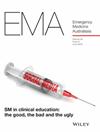Trauma team activation for older patients with pelvic fractures: Are current criteria adequate?
Abstract
Objectives
The present study aimed to identify the impact of age on current trauma team activation (TTA) processes and outcomes for patients with pelvic fractures.
Methods
Adult patients with moderate and/or severe pelvic fractures (Abbreviated Injury Scale ≥ 2) between 1 January 2016 and 31 December 2021 were included utilising major trauma hospital data in Queensland. Characteristics of older (age ≥ 65) and younger patients including TTA, interventions and outcomes were examined. Multivariate analysis was used to determine factors associated with TTA in older patients.
Results
Data from 637 patients was included. Despite comparable injury severity, a TTA was activated in fewer older people (older: 65% vs. younger: 79%, P < 0.001). Older patients had more falls leading to the trauma presentation (54.4% vs. 22.6%, P < 0.001), with higher initial systolic BP (131 vs. 125 mmHg, P = 0.04). Outcomes were worse for older people, with greater rates of in-hospital complications (27.2% vs. 16.4%, P = 0.004), and longer hospital stays (12 vs. 8 days, P = 0.04). Fewer older patients could be discharged independently to home (46.3% vs. 74.5%, P < 0.001). In older patients, falls and haemodynamic parameters were strongly associated with the reduced likelihood of TTA (fall mechanism [odds ratio (OR)] 0.33; 95% confidence interval [CI] 0.15–0.74; P = 0.01; systolic BP [OR 0.98; 95% CI 0.97–0.99; P = 0.03], heart rate [OR 0.97; 95% CI 0.95–0.99; P = 0.02]).
Conclusion
Current TTA criteria based on higher energy mechanisms and traditional vital sign thresholds are inadequate for identifying injury in older patients. Sensitive triage criteria and increased clinician awareness are required to enhance injury recognition and improve outcomes in older trauma patients.

 求助内容:
求助内容: 应助结果提醒方式:
应助结果提醒方式:


